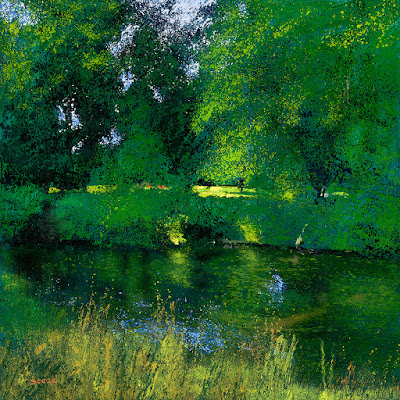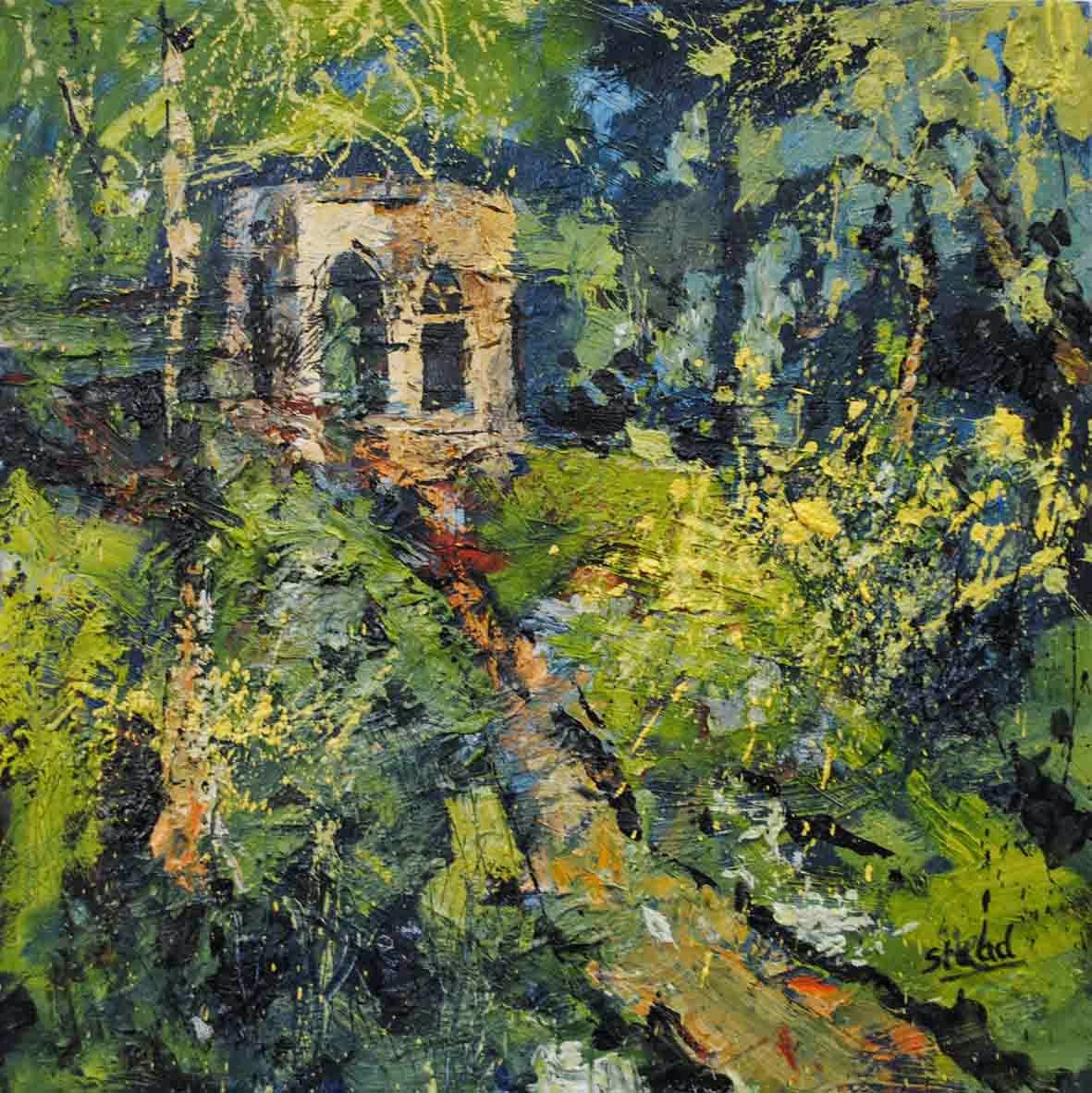Little did I think when I wrote ‘Making A Clean Breast Of It’, for Caught By The River in late 2015 that within the course of a year my life would become so powerfully linked to the scene of the ‘action’ - Norton Conyers House, and to the paintings that dangle from its ancient walls.
A chance conversation between my wife. and Lady Graham (yes, we do a bit of hob-nobbing the Mrs and I) led to moving studio from above my gallery where I’ve worked for fifteen years, four miles out of town to the grandly titled ’North Pavilion’ in the late 18thC stable block of Norton Conyers. I think it was actually a grain store in former times and was pretty run down, but after a bit of a sweep out, the installation of electricity and water, a woodburner and secondary glazing, it has turned into the perfect studio with plenty of space for painting and teaching. It has meant too, a change in lifestyle from predominantly city based to a more bucolic way of living, the studio being surrounded by woodland and open countryside and the much painted (by me), river Ure flows but a dog’s flob from its door. Stout, rubber wellington boots now form an essential part of my wardrobe and I’ve even had a bash at chewing bits of straw; though I do prefer the tapas bar in town.
As resident artist, my inexpert opinion is inexplicably sought when matters pertaining to decorative design or art arise and so, on a balmy, bee-buzzy, bird-songy afternoon in late summer, I was summoned to the darkly shuttered and eerie house to witness and record a homecoming: in a strange reversal of accepted practice, one of Norton Conyers illustrious residents was carried in rather than out of the house in a wooden box.
The resident in question, a certain Humphrey Morice Bt, who in life was described as ‘sickly, high and a little touchy’, had died some 230 years previously in Naples and so far as I can tell, had never even visited Norton Conyers, much less lived here. His handsome portrait by the well regarded Italian painter Pompeo Batoni however, had been resident in the dining room for many years and would probably have remained there had it not been for the incessant noise - not, as you might imagine, the raucous shenanigans of carousing aristocracy, but rather the clamorous sexual exploits of those uninvited, and rarely welcome guests - the death watch beetle.
The arrival of Xestobium rufovillosum meant the removal of most of the house’s fixtures and fittings including the portrait of Sir Humphrey, who’s exile was to last seven years; time spent in the tender care of the National Gallery. But this was the day of his homecoming: the box, (Sir Humph) is wheeled in. As caskets go this one is impressive - 6’ high, 8’ long and 2’ wide and it is borne or rather pushed as it’s on casters, by four porters, men who spend their lives moving incredibly valuable (or as in this case, not quite so valuable) works of art around the world. Their work is carried out with a kind of deft reverence laced with darkish humour such as one might witness at an undertakers convention or at a below stairs meeting of Blandings butlers.
Once de-boxed the painting is laid on the dining table for inspection. Sir Humphrey’s stockinged and silken clad form lounges somewhat incongruously in a classical landscape, by his side an innocent gun and evidence of a jovial morning’s wildlife extermination in the form of a dead hare and a brace or two of wild partridge. At the same time and possibly hoping to avoid the same fate, a trio of nervous looking hounds fawn at his feet. I feel I should say of Sir Humphrey: he doesn’t look like a man who’s spent the past few hours crashing through the undergrowth in pursuit of his lunch; he looks more like he’d been wandering the streets of Napoli in search of silken fripperies or penning poetry to an Italian peasant boy, but whatever the case, the scene is adroitly painted and will look magnificent above the splendid marble fireplace.
The portrait had hung for many years, dirty and all but forgotten in a dark, library corridor and it was only after cleaning that its quality was recognised; it has also undergone a certain amount of restoration whilst at the National and this is examined in minute detail by Sir James, Lady Halina and indeed myself. Spotting the restoration without expert help may have taken some time as they’ve made a cracking job of it. Once scrutinised, Lady Graham indulges in a little light house work which takes the form of dusting the gilt frame with a paint brush and then all that’s left to do is the re-hanging.
I say ‘all’ but I’m glad I’m not in charge - this is a substantial painting and I’m happy to leave its elevation to others and as it turns out ‘elevation’ seems fitting as there is a Rubensian beauty to the unfolding scene which reminds me of his ‘Elevation Of The Cross’ only mercifully with more clothing. Step-ladders are erected either side of the fireplace and a good deal of time is spent measuring and marking before the drill is brought into play (screws replacing the traditional crucifixion nails) and the brackets go up. Two of the National Gallery’s finest position themselves atop the ladders, one foot on the ladder, the other balletically tip-toe’d on the mantle whilst the others gather up Sir Humph and his attendant fauna. Together they hoist the painted peer into place, forming as they do the neo-baroque (or perhaps more Stanley Spencer) tableaux. We all stand back and adopt the tics that help decide whether it’s straight or not: stroking our chins, cocking our heads on one side and puffing out our cheeks; is it straight? Of course it is - these lads know what they’re about.
Before long we’re stretching out on the lawn in the walled garden, or more properly: ‘lounging in a classical landscape’, only that’s where the comparison ends as we have a beer in our hands and the wildlife is still vigorously sentient around us. It’s tempting to make a drawing of the scene but Batoni has rather cornered the market in lounging baronets so I let it go.















